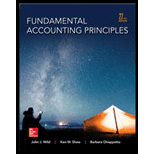
Concept explainers
1)
Introduction:
Cash Flow Statements:
• Cash flow statements are an integral part of the financial statements of a company. They reflect the direction and movement of the
•
• Cash flows from Investing activities – The cash inflows refer to sales and income from investing activities and cash outflows include cash outflows from the investing activities in the form of purchase of fixed assets and investments.
• Cash flows from Financing activities – The cash inflows refer to income from financing activities such as raising share capital and debt and cash outflows include cash outflows from the financing activities in the form of dividends and interest paid.
There are two methods of preparing cash flow statements:
• Direct Method – It measures the actual cash inflows and cash outflows that are affected during a particular reporting period. The actual cash flows do not include non-cash items and items that are recorded owing to the accrual principle.
• Indirect Method –It measures the cash inflows and cash outflows that are affected during a particular reporting period including the non-cash items and items that are recorded owing to the accrual principle.
To Determine:
The reporting objectives of the cash flow statements.
2)
Introduction:
Cash Flow Statements:
• Cash flow statements are an integral part of the financial statements of a company. They reflect the direction and movement of the cash inflows and outflows during a reporting period. The cash inflows and outflows are segregated into the following activities:
• Cash flows from Operating activities – The cash inflows refer to sales and income from operating activities and cash outflows include both cash and non-cash outflows from the operating activities i.e. the day to day activities of the business.
• Cash flows from Investing activities – The cash inflows refer to sales and income from investing activities and cash outflows include cash outflows from the investing activities in the form of purchase of fixed assets and investments.
• Cash flows from Financing activities – The cash inflows refer to income from financing activities such as raising share capital and debt and cash outflows include cash outflows from the financing activities in the form of dividends and interest paid.
To Determine:
Method of reconciling net income to cash flows from operating activities for non-cash items.
3)
Introduction:
Cash Flow Statements:
• Cash flow statements are an integral part of the financial statements of a company. They reflect the direction and movement of the cash inflows and outflows during a reporting period. The cash inflows and outflows are segregated into the following activities:
• Cash flows from Operating activities – The cash inflows refer to sales and income from operating activities and cash outflows include both cash and non-cash outflows from the operating activities i.e. the day to day activities of the business.
• Cash flows from Investing activities – The cash inflows refer to sales and income from investing activities and cash outflows include cash outflows from the investing activities in the form of purchase of fixed assets and investments.
• Cash flows from Financing activities – The cash inflows refer to income from financing activities such as raising share capital and debt and cash outflows include cash outflows from the financing activities in the form of dividends and interest paid.
There are two methods of preparing cash flow statements:
• Direct Method – It measures the actual cash inflows and cash outflows that are affected during a particular reporting period. The actual cash flows do not include non-cash items and items that are recorded owing to the accrual principle.
• Indirect Method –It measures the cash inflows and cash outflows that are affected during a particular reporting period including the non-cash items and items that are recorded owing to the accrual principle.
To Determine:
Formula for computing Cash receipts from Sale to Customers under the direct method.
Want to see the full answer?
Check out a sample textbook solution
Chapter 16 Solutions
Fundamental Accounting Principles -Hardcover
- At the beginning of the year, Andrews Corporation has assets of $240,000 and equity of $175,000. During the year, assets increase by $95,000 and liabilities increase by $72,000. What is the equity at the end of the year?arrow_forwardI am looking for the correct answer to this general accounting problem using valid accounting standards.arrow_forwardWhat distinguishes qualitative boundary analysis from quantity limits? (a) Quality factors create confusion (b) Numbers alone determine boundaries (c) Nature of transactions affects classification beyond size (d) Size limits work perfectlyarrow_forward
- I need help solving this general accounting question with the proper methodology.arrow_forwardHorizon Industries has sales of $250,000 and the cost of goods available for sale of $215,000. If the gross profit rate is 38.75%, the estimated cost of the ending inventory under the gross profit method is?arrow_forwardCan you help me solve this general accounting question using valid accounting techniques?arrow_forward
- Can you explain the process for solving this financial accounting question accurately?arrow_forwardFor this year, Jameson Corporation has $32,000 net earnings on the income statement and $14,000 net cash inflow from operating activities, $22,000 net cash outflow from investing activities, and $18,000 cash inflow from financing activities on the statement of cash flows. What is the accruals total reported for this period?arrow_forwardPlease provide the solution to this general accounting question with accurate financial calculations.arrow_forward

 AccountingAccountingISBN:9781337272094Author:WARREN, Carl S., Reeve, James M., Duchac, Jonathan E.Publisher:Cengage Learning,
AccountingAccountingISBN:9781337272094Author:WARREN, Carl S., Reeve, James M., Duchac, Jonathan E.Publisher:Cengage Learning, Accounting Information SystemsAccountingISBN:9781337619202Author:Hall, James A.Publisher:Cengage Learning,
Accounting Information SystemsAccountingISBN:9781337619202Author:Hall, James A.Publisher:Cengage Learning, Horngren's Cost Accounting: A Managerial Emphasis...AccountingISBN:9780134475585Author:Srikant M. Datar, Madhav V. RajanPublisher:PEARSON
Horngren's Cost Accounting: A Managerial Emphasis...AccountingISBN:9780134475585Author:Srikant M. Datar, Madhav V. RajanPublisher:PEARSON Intermediate AccountingAccountingISBN:9781259722660Author:J. David Spiceland, Mark W. Nelson, Wayne M ThomasPublisher:McGraw-Hill Education
Intermediate AccountingAccountingISBN:9781259722660Author:J. David Spiceland, Mark W. Nelson, Wayne M ThomasPublisher:McGraw-Hill Education Financial and Managerial AccountingAccountingISBN:9781259726705Author:John J Wild, Ken W. Shaw, Barbara Chiappetta Fundamental Accounting PrinciplesPublisher:McGraw-Hill Education
Financial and Managerial AccountingAccountingISBN:9781259726705Author:John J Wild, Ken W. Shaw, Barbara Chiappetta Fundamental Accounting PrinciplesPublisher:McGraw-Hill Education





